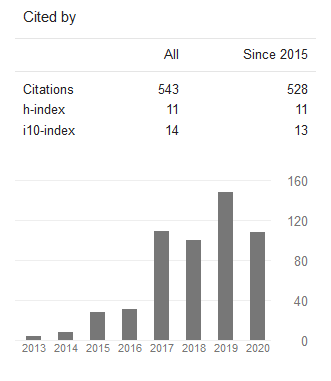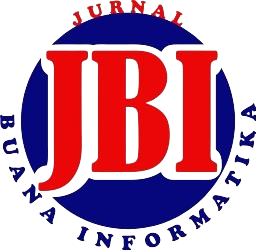Analisis Pengaruh Citra Gelap, Normal, Terang Terhadap Wavelet Orthogonal
DOI:
https://doi.org/10.24002/jbi.v9i2.1698Abstract
Abstract. An image is classified into dark, normal, and bright image. The images are grouped in the dark images according to the histogram and the mu value. An image consists of information and redundancies. The use of wavelet is considered effective in image compression and it does not only cut down the memory usage but also it makes devices work faster. In this study, an analysis in conducted on the influence of dark, normal, and bright images on the orthogonal wavelet. Peak Signal to Noise Ratio (PSNR) is used to compare 17 functions of wavelet orthogonal in the image compression of dark, normal, and bright images. PSNR is a measurement parameter commonly used for measuring the quality of image reconstruction which is then compared with the original image. Compression ratio is used to measure the reduction of the data size after the compression process. Based on the research on the dark, normal, and bright image, the findings reveal that bright image has got the lowest PNSR value at all image testing while the normal image has the highest PSNR value at the wavelet orthogonal application.
Keywords : Image compression, Orthogonal wavelet, PSNR, compression ratio.
Abstrak. Suatu citra dikelompokkan menjadi citra gelap, citra normal, dan citra terang. Pengelompokan citra menjadi warna gelap terlihat dari histogram dan nilai rerata intensitas (mu). Citra terdiri atas informasi dan redudansi. Penggunaan wavelet dinilai efektif dalam kompresi citra dan menurunkan penggunaan memori serta membuat perangkat menjadi lebih cepat. Pada penelitian ini, dilakukan analisis pengaruh citra gelap, citra normal, dan citra terang terhadap wavelet orthogonal. Peak Signal to Noise Ratio (PSNR) digunakan untuk membandingkan 17 fungsi wavelet orthogonal dalam kompresi citra gelap, citra normal, dan citra terang. PSNR adalah parameter ukur yang sering digunakan untuk pengukuran kualitas gambar rekonstruksi, yang lalu dibandingkan dengan gambar asli. Rasio kompresi digunakan untuk mengukur pengurangan ukuran data setelah proses kompresi. Berdasarkan penelitian pada citra gelap, citra normal, dan citra terang diperoleh bahwa citra terang menghasilkan nilai PSNR paling kecil untuk seluruh citra uji dan citra normal menghasilkan nilai PSNR paling besar dalam penerapan wavelet orthogonal.
Kata kunci : Kompresi citra, Wavelet orthogonal, PSNR, rasio kompresi.
References
A. Kadir, & A. Susanto, Teori dan Aplikasi Pengolahan Citra. Yogyakarta: Penerbit ANDI, 2013.
S. Zhong, X. Jiang, J. Wei, & Z. Wei, “Image enhancement based on wavelet transformation and pseudo-color coding with phase-modulated image density processing,” Infrared Physics & Technology, vol. 58, pp. 56–63, 2013.
Z. Zhang, Q. K. Telesford, C. Giusti, K. O. Lim, & D. S. Bassett, “Choosing Wavelet Methods, Filters, and Lengths for Functional Brain Network Construction,” Plos One, vol. 11, no. 6, pp. 1-24, 2016.
L. Ebadi & H. Z. M. Shafri, “Compression of remote sensing data using second-generation wavelets: a review,” Environmental Earth Sciences, vol. 71, no. 3, pp. 1379–1387, 2013.
A. Garg, S. V. Naidu, T. Ahmed, H. Yahia, & D. Singh, “Wavelet based resolution enhancement for low resolution satellite images,” 2014 9th International Conference on Industrial and Information Systems (ICIIS), 2014.
S. Peng, "Compressed Sensing Image Reconstruction Based on Discrete Shearlet Transform," Sensors & Transducers, vol. 181, no. 10, pp. 127-133, October 2014.
A. J. Santoso, L. E. Nugroho, G. B.Suparta, & R. Hidayat, " Color Image Compression Using Orthogonal Wavelet Viewed From Decomposition Level and Peak Signal to Noise Ratio," International Journal of Advanced Science and Technology, vol. 31, pp. 81-92, 2011.
L. Gagnon, "Wavelet Filtering of Speckle Noise-Some Numerical Results," Proceedings of the conference Vision Interface, pp. 336-343, 1999.
N. Kristianti & A. J. Santoso, "ORTHOGONAL WAVELET FUNCTION FOR COMPRESSION SATELLITE IMAGERY OF PEAT FOREST FIRES," Journal of Theoretical & Applied Information Technology, vol. 96, no. 9, 2018.
I. Daubechies, Ten lectures on wavelets. Philadelphia, PA: Societyfor Industrialand Applied Mathematics, 2006.
G. Beylkin, R. Coifman, & V. Rokhlin, “Fast wavelet transforms and numerical algorithms,” Communications on pure and applied mathematics , vol. 44, no. 2, pp. 141-183, 1991.
A. M. Kishk, N. W. Messiha, N. A. El-Fishawy, A. E. A. Alkafs, &A. H. Madian, "Low Energy Lossless Image Compression Algorithm for Wireless Sensor Network (LE-LICA)," Sensors & Transducers, vol. 188, no. 5, pp. 102-106, May 2015.
P. Jain & V. Tyagi, “A survey of edge-preserving image denoising methods,” Information Systems Frontiers, vol. 18, no. 1, pp. 159–170, 2014.
A. J. Santoso, F. K. S. Dewi, & T. A. P. Sidhi, “Compression of Satellite Imagery Sequences Using Wavelet for Detection of Natural Disaster,” International Journal of Advanced Science and Technology, vol. 62, pp. 55–64, 2014.
A. M. Raid, W. M. Khedr, M. A. El-dosuky, & W. Ahmed, "Jpeg Image Compression Using Discrete Cosine Transform - A Survey," International Journal of Computer Science & Engineering Survey (IJCSES) , vol. 5, pp. 39-47, April 2014.
S. Abhishek, S. Veni, & K. Narayanankutty, “Splines in Compressed Sensing,” International Journal on Advanced Science, Engineering and Information Technology, vol. 6, no. 4, pp. 469-476, 2016.
N. Saroya & P. Kaur, "Analysis of IMAGE COMPRESSION Algorithm Using DCT and DWT Transforms," International Journal of Advanced Research in Computer Science and Software Engineering, vol. 4, no. 2, pp. 897-900, February 2014.
Downloads
Published
Issue
Section
License
Copyright of this journal is assigned to Jurnal Buana Informatika as the journal publisher by the knowledge of author, whilst the moral right of the publication belongs to author. Every printed and electronic publications are open access for educational purposes, research, and library. The editorial board is not responsible for copyright violation to the other than them aims mentioned before. The reproduction of any part of this journal (printed or online) will be allowed only with a written permission from Jurnal Buana Informatika.
This work is licensed under a Creative Commons Attribution-ShareAlike 4.0 International License.










